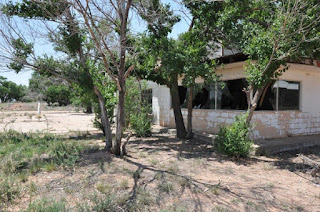If you have ever wanted to kiss the Blarney Stone, but haven't because you can't afford an expensive trip to Ireland, Texas has you covered. The town of Shamrock is located in the Panhandle of Texas, just across the border from Oklahoma. In 1890, mail in the area was served by George and Nora Nickel in a dugout on their property. George's Irish mother had often told him to depend on a shamrock to bring him good luck so that's what he named the town. Shamrock loves its Irish heritage so much that in 1959, city leaders managed to buy an actual piece of the lucky rock from Cork, Ireland's Blarney Castle.
When the rock was delivered with the authentication papers, they embedded it into a theft-proof concrete pedestal, exposed for anyone who wanted kiss it. Why would anyone want to put their lips to a rock that has now had thousands of other people's lips touch it? Legend has it that when you kiss the Blarney Stone, you will be given the gift of eloquence and persuasiveness.
Set in an upper wall of Blarney Castle, constructed in 1446 by Dermot McCarthy, King of Munster, the stone, according to popular legend, was originally the stone of Jacob from the Book of Genesis. It was acquired during the Crusades and brought to Ireland. In 1558, Queen Elizabeth 1 decided she wanted the magnificent Blarney Castle (then known as the McCarthy castle) for her own. She sent the Earle of Leicester to seize it, but Cormac McCarthy, the head of the family, had the gift of gab and was so eloquent that he managed to keep stalling the process of turning over his castle to the Queen. The queen became so exasperated by the earl's reports about the lack of progress that she said his reports were all "Blarney." The castle was never turned over to the queen and has since been known as the Blarney Castle. Kissing the Blarney Stone will impart this gift of gab to the kisser.
Today, Shamrock's piece of the Blarney Stone sits in it's pedestal in a small park surrounded by older houses. Unless you intentionally go there to see it and actually walk into the park to find it, you most probably would pay no notice to it. The day I visited, the park was empty except for one little boy who intently watched me as he was slowly swinging back and forth on the old swing set. I took a few pictures of the stone which, apparently bored him so much that he left and walked into a nearby house. Just me and the stone so yes, after wiping it down with a Clorox wipe I retrieved from my truck, I bent over and gave that rock a quick little kiss. I don't think it gave me the rumored gift of gab, but my wife and friends might disagree.
Shamrock slowly grew, especially in the 1920's when oil and gas were discovered in the area. In 1936, the U-Drop Inn was built at the corner of Route 66 and Route 83. It did a booming business as it was the only café within 100 miles of Shamrock. It was considered one of the most beautiful buildings on Route 66, but when the road was decommissioned, it was abandoned and fell into disrepair. In 1997, however, the crumbling building was placed on the National Register of Historic Places and in 1999, the First National Bank of Shamrock purchased it and donated the structure to the city. The city then received a $1.7 million grant from the federal government and a firm specializing in restoring historical buildings was commissioned to bring it back to its former glory. The firm did an excellent job and today it houses a visitor center, a museum, and a gift center as well the city's Chamber of Commerce. It has become an iconic "must stop" for thousands of old Route 66 travelers and is probably most famous for being the inspiration for Ramone's Body Shop in the 2006 movie, "Cars."
Shamrock has never been very big though. Even at its peak there were only 3,778 residents. When Route 66 and the city was bypassed by the construction of I-40, business declined and the population fell to to its current 1,910. It swells considerably however, during its annual St. Patrick's Day Celebration weekend. Held every year since 1938 (except during WW II), the festival marks the end of its "Irish Donegal Beard-growing" contest. Each contestant must provide photographic proof of a stubble-free face as of January 1st. The men then grow as much beard as they can before St. Patrick's Day. Adult males opting not to participate must buy a $5 shaving permit or risk being thrown in jail during the festival! In addition to announcing the year's Ms. Shamrock, activities include a banquet, parade, Irish stew cook-off, antique car show, carnival, arts & crafts, a bull buck-out and more. And a good time is had by all in this little Irish town in Texas.



















































